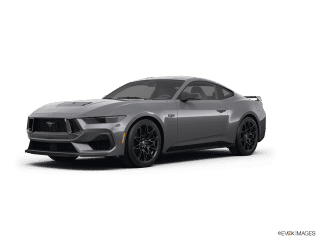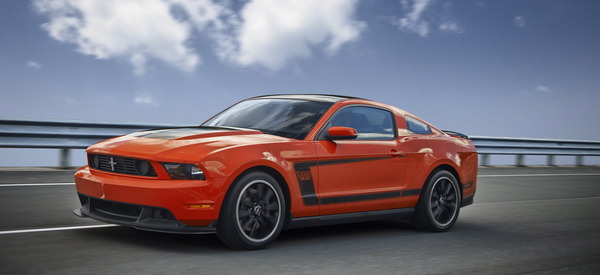
2012 Ford Mustang Boss 302
Review: 2012 Ford Mustang Boss 302
The muscle car era is back and better than ever.
Web2Carz Contributing Writer
Published: December 22nd, 2011
Everything old is new again, at least when it comes to pony cars.
Think about it. All three of Detroit’s entries (Ford Mustang, Chevrolet Camaro, and Dodge Challenger) trade on retro themes, and do so successfully. We don’t complain because the formula of big power and rear-drive in a car with a long hood and short deck equals major fun. And these cars are affordable to boot.
So it was only natural that Ford would bring back the Boss Mustang. Those who remember the late ‘60s and early ‘70s—and many who were alive back then don’t—will recall that the Boss was a limited-edition track-day pony that ended up being one of the iconic Mustangs of its day. Surviving examples can fetch top-dollar on the collector-car market.
-
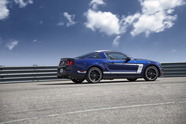
Bringing Back The Boss
When Ford resurrected the Boss 302 for 2012, it had a challenge on its hands—how could it make the car fit between the 412-horsepower GT and the 550-horse Shelby GT, which is often compared to some of the best production sports cars in the world?
Numerically, the challenge was easy—the Blue Oval gave the Boss 444 ponies. The company also priced the Boss in between the GT and the Shelby.
That doesn’t mean the Boss is just meant to be a step between the GT and the Shelby. Far from it. The Boss and Shelby are different animals. For one, the Boss uses the same 5.0-liter V-8 from the GT (albeit heavily massaged) while the Shelby has a 5.4-liter supercharged V-8. The Shelby is meant to play with Corvettes, the Boss is meant to slide around the track.
The Boss is also expected to be one of the most desirable Mustangs of modern times. We can’t speak to its track prowess (at least not firsthand), but we can vouch for the latter. -
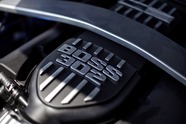
Under The Hood
In order to gain the extra power, Ford revised the camshafts, went more aggressive with the engine-control calibration, and used a specifically tuned intake to reduce airflow restriction.
That’s not all: the Boss gets a unique exhaust system with four outlets—two in the rear, and one on each side. A heavy-duty clutch pairs with a short-throw shifter on the six-speed manual transmission to get that power to the rear end, and a 3.73-ratio rear axle with a limited-slip differential (a Torsion limited-slip is available when coupled with Recaro racing seats) puts that power to the rear wheels.
Add in a stripe job that reminds of the Bosses of yore, a TracKey (more on that later), unique traction-control and stability-control settings, and a re-tuned suspension and steering system, and you have a Sunday ride that isn’t destined for church.
Ford re-tuned the suspension by adding higher-rate coil springs at all four wheels and stiffer suspension bushings, plus a larger rear stabilizer bar. The car is also lowered by 11 millimeters up front and 1 millimeter in back. The suspension is also adjustable by the driver, as is the exhaust. The steering offers three modes: Comfort, Sport, and Normal.
Bosses get Brembo brakes and 19-inch wheels, a unique front fascia and grille, a rear spoiler, and a black or white roof panel that is keyed to the color of the striping. The steering wheel is covered in Alcantara suede, while the cloth seats have suede-like inserts.
Bring the Boss to life, and it’s clear you have something special in your hands. The 5.0-liter makes sounds that you might expect to hear only in car-guy heaven, and that’s just at idle. Rev it up, and the sound is pure delight. It’s one of the best factory exhaust sounds we’ve heard in years. -

Hitting The Road
Of course, cars like this are as much about the “go†as the “showâ€, and the Boss delivers. Want to make pavement disappear in a hurry? No problem. The Boss leaps forward with purpose when pressed, with an urgency that’s alarming to the unsuspecting. It’s fun to play “scare the passenger.â€
Acceleration like that should only be reserved for those with surnames like Gurney and Andretti, and it seems wasted around town—a bit like using a bazooka to kill a fly. But dammit if overkill ain’t fun. Watching the distance shrink makes you feel like you’re in a time warp, and given the spirit of this car, you kinda are.
The short-throw shifter feels like something right out of the muscle-car playbook, allowing for satisfying shifts, although it does occasionally refuse entry to a gate, and it’s easier than it should be to slide into the wrong gate. Nevertheless, both the shifter and appropriately heavy clutch are not burdensome around town.
Neither is the car in general—the Boss is as docile around town as any other Mustang, with even the engine fading into the background when in cruise mode. The ride isn’t especially punishing, despite the suspension tuning, although its mission does remain clear. The Boss wouldn’t be our first choice for any cruise not involving Woodward Avenue, but despite the bumps and bounces, it doesn’t exhaust the driver. The adjustable suspension makes for a cool plaything—all it takes is a flathead screwdriver and one can noticeably soften or tighten the car’s handling. We tried it, and there was definitely a character change.
When pushed on a back road, the Boss feels smooth and planted, although the numb steering disappoints. Changing the steering mode helps only marginally—this is a flaw that carries over from lesser Mustangs. The brakes, however, do not disappoint—many a wandering deer will be spared.
Thanks to the exterior upgrades, the Boss looks, well, boss, but the interior is mostly standard Mustang fare, meaning it’s more than a little behind the times. -
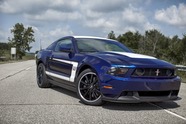
Features & Prices
We suspect buyers won’t care, though. For those who want more race car and less street car, an available Laguna Seca package removes the rear seat and adds racier aerodynamics and suspension components.
Another Boss goodie is the available TracKey, which allows owners to give the car a Dr. Jekyll and Mr. Hyde split personality using a special key. The car’s wilder side includes a launch-control system to help drivers achieve near-perfect takeoffs at the drag strip.
Performance doesn’t come without cost, and our tester listed at $40,145. The Recaro seats and Torsen limited-slip added $1,995 to the cost, and with the $850 destination fee, the total came to $42,990. We expect that given the limited availability of the Boss, the price paid at the dealer will be a wee bit higher. -
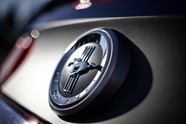
Fuel Economy--For Those Who Care About Such Things
Fuel economy is rated at 17 mpg city and 26 mpg highway, which is impressive, but we suspect most owners won’t achieve anywhere near that. We averaged in the neighborhood of 14 mpg, albeit with plenty of hooning. That’s OK. Ford isn’t building this car to meet CAFE requirements. No, Ford is building the Boss because it wants track-day superiority.
-

The Wrap-Up
Ford got more than that, though. Thanks to its civilized around-town behavior, impressive sounds, and acceleration that will renew your faith in all that’s holy, the Boss actually makes a case for being the best factory Mustang Ford has ever built (yes, even better than the Shelby). It’s too bad that production is limited—everyone should have a chance to buy a car like this.
That would be pretty boss.
• For more information such as specs, prices, and photos of the 2012 Ford Mustang, click here: 2012 Ford Mustang.














